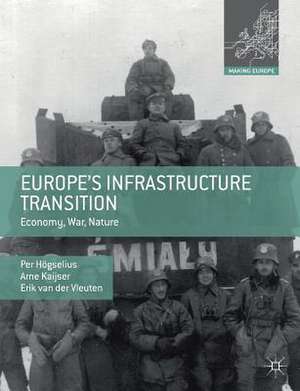Europe’s Infrastructure Transition: Economy, War, Nature: Making Europe
Autor Per Högselius, Arne Kaijser, Erik van der Vleutenen Limba Engleză Paperback – 28 iun 2018
Preț: 217.35 lei
Nou
Puncte Express: 326
Preț estimativ în valută:
41.60€ • 43.67$ • 34.37£
41.60€ • 43.67$ • 34.37£
Carte tipărită la comandă
Livrare economică 30 ianuarie-13 februarie 25
Preluare comenzi: 021 569.72.76
Specificații
ISBN-13: 9780230308008
ISBN-10: 0230308007
Pagini: 454
Ilustrații: XXIV, 454 p.
Dimensiuni: 189 x 246 mm
Greutate: 0.85 kg
Ediția:1st ed. 2016
Editura: Palgrave Macmillan UK
Colecția Palgrave Macmillan
Seria Making Europe
Locul publicării:London, United Kingdom
ISBN-10: 0230308007
Pagini: 454
Ilustrații: XXIV, 454 p.
Dimensiuni: 189 x 246 mm
Greutate: 0.85 kg
Ediția:1st ed. 2016
Editura: Palgrave Macmillan UK
Colecția Palgrave Macmillan
Seria Making Europe
Locul publicării:London, United Kingdom
Cuprins
1. Manipulating Space and Time. - 2. Fueling Europe. - 3. Networked Food Economy. - 4. Factory and Finance. - 5. Logistics of War. - 6. Linking Land. - 7. Troubled Waters. - 8. Common Skies
Recenzii
“In Europe’s Infrastructure Transition, Högselius, Kaijser, and van der Vleuten have done an impressive job tracing the symbiotic relations between transportation and communication systems, between system-building and border-building, and between technocracy and nature. The writing is highly readable and the arguments compelling. … This book will therefore likely appeal to academic and non-academic readers alike, and is quite suitable for collegiate classroom use. … this is a thoughtful, engaging, and important book.” (Nicholas Ostrum, CritCom, councilforeuropeanstudies.org, June, 2016)
Notă biografică
Per Högselius is Associate Professor at the Division of History of Science, Technology and Environment at KTH Royal Institute of Technology, Stockholm, Sweden. His research has focused on international aspects and in particular East-West relations in the history of science, technology, and environment. Most recently he published Red Gas: Russia and the Origins of European Energy Dependence (2013).
Arne Kaijser is Professor of History of Technology at KTH Royal Institute of Technology, Stockholm, Sweden. His main research interests concern infrastructure, institutions, and environment in historical perspective. Together with Erik van der Vleuten he edited Networking Europe: Transnational Infrastructures and the shaping of Europe, 1850-2000 (2006).
Erik van der Vleuten is Professor of History of Technology at Eindhoven University of Technology, the Netherlands, and scientific director of the Foundation for the History of Technology (SHT). In 2013-2015 he chaired the Pan-European research network Tensions of Europe: Technology and the Making of Europe. With Högselius and Kaijser he authored Europe’s Infrastructure Transition: Economy, War, Nature (2015).
Arne Kaijser is Professor of History of Technology at KTH Royal Institute of Technology, Stockholm, Sweden. His main research interests concern infrastructure, institutions, and environment in historical perspective. Together with Erik van der Vleuten he edited Networking Europe: Transnational Infrastructures and the shaping of Europe, 1850-2000 (2006).
Erik van der Vleuten is Professor of History of Technology at Eindhoven University of Technology, the Netherlands, and scientific director of the Foundation for the History of Technology (SHT). In 2013-2015 he chaired the Pan-European research network Tensions of Europe: Technology and the Making of Europe. With Högselius and Kaijser he authored Europe’s Infrastructure Transition: Economy, War, Nature (2015).
Textul de pe ultima copertă
Europe's critical infrastructure is a key concern to policymakers, NGOs, companies, and citizens today. A 2006 power line failure in northern Germany closed lights in Portugal in a matter of seconds. Several Russian-Ukrainian gas crises shocked politicians, entrepreneurs, and citizens thousands of kilometers away in Germany, France, and Italy. This book argues that present-day infrastructure vulnerabilities resulted from choices of infrastructure builders in the past. It inquires which, and whose, vulnerabilities they perceived, negotiated, prioritized, and inscribed in Europe's critical infrastructure. It does not take 'Europe' for granted, but actively investigates which countries and peoples were historically connected in joint interdependency, and why. In short, this collection unravels the simultaneous historical shaping of infrastructure, common vulnerabilities, and Europe.





